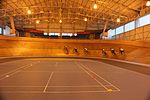Calshot Marshes
Local Nature Reserves in Hampshire

Calshot Marshes is a 51.1-hectare (126-acre) Local Nature Reserve near Calshot, at the junction of The Solent and Southampton Water in Hampshire. It is owned by Hampshire County Council and managed by Hampshire Countryside Service. It is part of Solent and Southampton Water Ramsar site and Special Protection Area, of Solent Maritime Special Area of Conservation and of Hythe to Calshot Marshes Site of Special Scientific Interest.This saltmarsh site is internationally important for dark-bellied brent geese and nationally important for wigeon, teal, ringed plover, grey plover, black-tailed godwit, redshank and dunlin.
Excerpt from the Wikipedia article Calshot Marshes (License: CC BY-SA 3.0, Authors, Images).Calshot Marshes
Channel Mouth Road, New Forest Fawley
Geographical coordinates (GPS) Address Nearby Places Show on map
Geographical coordinates (GPS)
| Latitude | Longitude |
|---|---|
| N 50.818 ° | E -1.316 ° |
Address
Calshot Marsh Nature Reserve
Channel Mouth Road
SO45 1TW New Forest, Fawley
England, United Kingdom
Open on Google Maps










